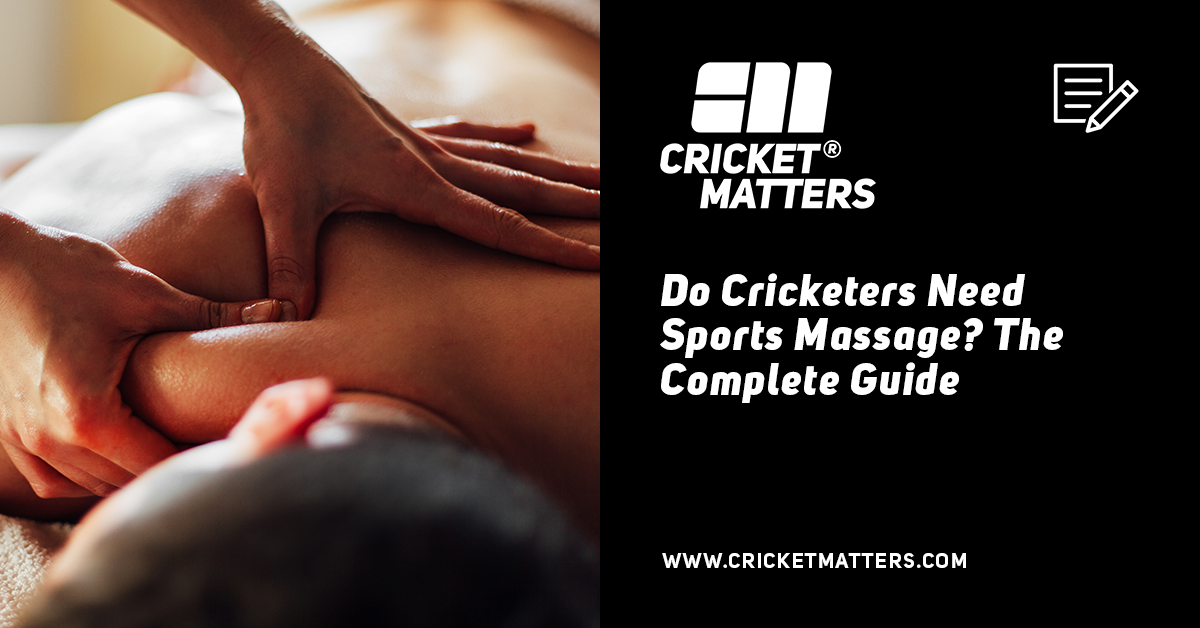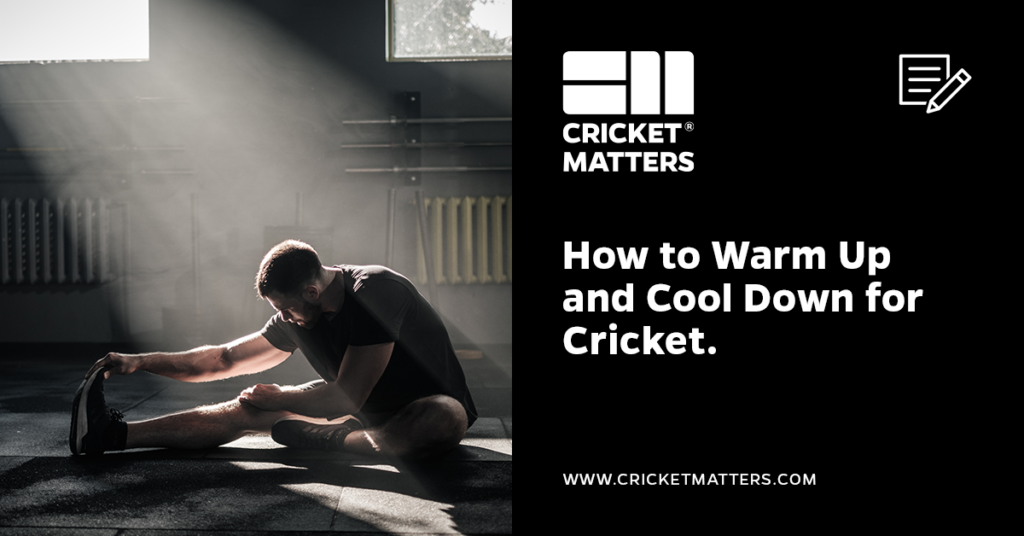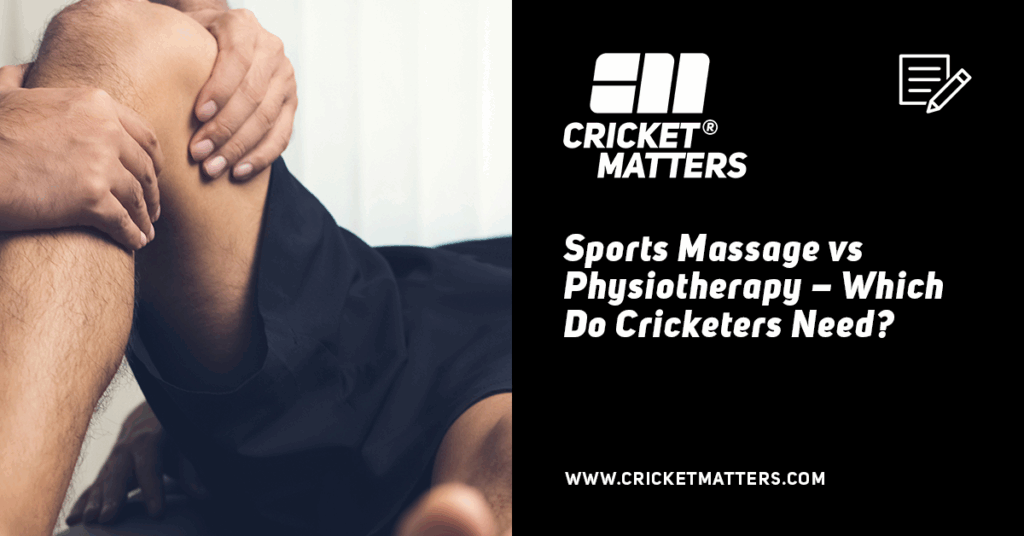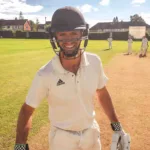
I hope you enjoy reading this blog post.
James Breese, Cricket Matters FounderIf you need my help with cricket coaching, strength and conditioning, injury rehab, or nutrition, click here.
Tight shoulders. Stiff hips. Heavy legs. A back that aches more than it should. Every cricketer knows the feeling — but few stop to realise just how much it steals from their game. That tension doesn’t just make you sore the next morning; it robs you of rotation, cuts down your stride, blunts your timing, and quietly erodes your technique. Left unchecked, it builds into fatigue, niggles, and injuries.
Most players shrug it off as “just part of cricket.”
Long matches, packed schedules, endless travel — stiffness and soreness become the norm. But here’s the truth: they don’t have to be. Playing in pain or dragging yourself through recovery isn’t toughness. It’s a roadblock to consistency and performance.
That’s where sports massage comes in.
Forget the spa-day stereotype. Done properly, it’s one of the most effective recovery tools available to cricketers.
In this guide, we’ll break down what sports massage really is, the research-backed benefits, and the practical ways you can use it to stay fresher, stronger, and ready to perform every ball.
Playing in pain isn’t toughness — it’s a roadblock to performance.
Table of Contents
What is Sports Massage, Really?
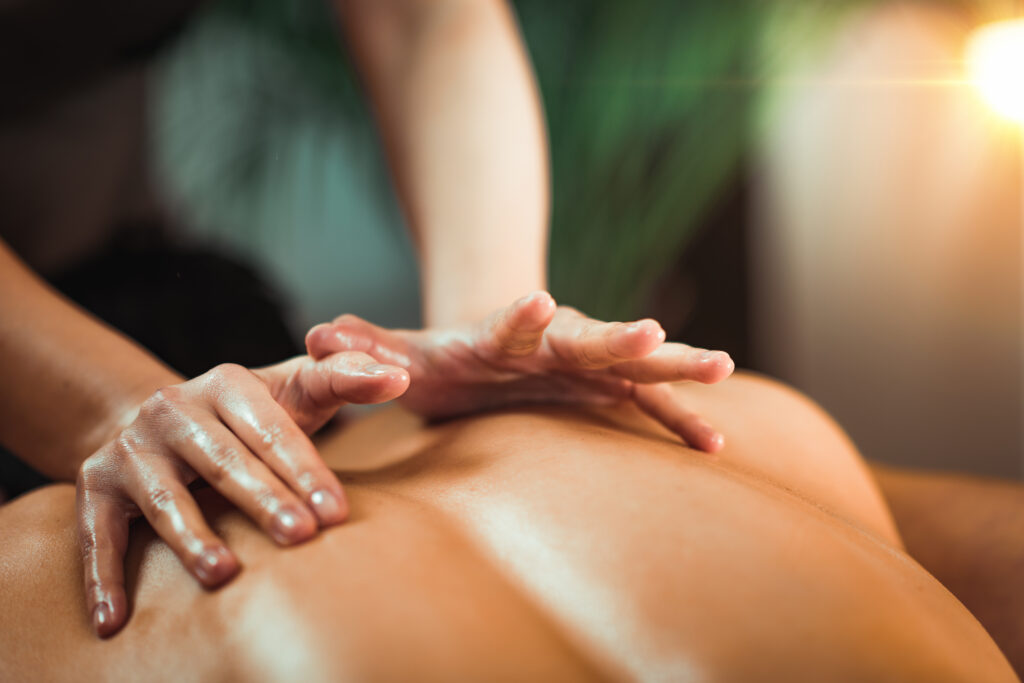
Sports massage is targeted, deep-tissue therapy designed to meet the demands of athletes — and in cricket, those demands are unlike any other sport.
This isn’t about spa relaxation. It’s about recovery, injury prevention, and keeping your body moving the way it should when the pressure’s on.
A therapist who truly understands cricket won’t just sweep over big muscle groups.
They’ll go after the areas that take the heaviest load: the shins and anterior tibialis from repeated sprints and hours in the field; the rotator cuff and shoulder complex hammered by endless bowling and throwing; the obliques, quadratus lumborum, and serratus anterior that drive power and rotation in batting; and the neck, where hidden tension often drags a batsman’s head off-line and wrecks balance.
These aren’t random targets. They’re the engine room of cricket movement.
When they tighten up, your stride shortens, your bat swing slows, your shoulders stiffen, and your back starts to complain. Over time, those small restrictions chip away at technique and consistency. Addressed properly, they unlock freer rotation, smoother actions, and the ability to train harder and play sharper without breaking down.
That’s the true value of sports massage for cricketers: precise, intelligent treatment that acts as performance upkeep — not pampering.
The Benefits of Sports Massage for Cricketers (Backed by Research)
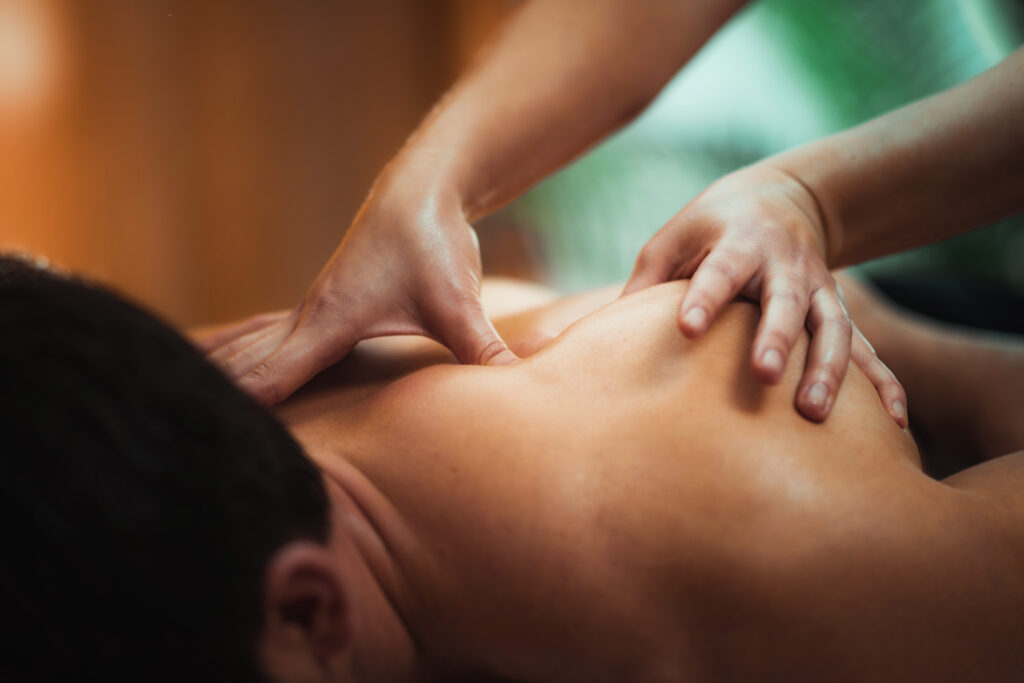
Here’s what the research actually shows: sports massage isn’t magic, and it won’t suddenly add 10mph to your bowling. But used correctly, it delivers proven recovery and psychological benefits that directly influence performance in cricket. From faster bounce-back between matches to sharper focus under pressure, massage remains one of the most overlooked tools in a cricketer’s arsenal.
Improves Recovery and Reduces Muscle Soreness
Every cricketer knows the ache of DOMS — the delayed soreness that bites a day or two after heavy training or back-to-back fixtures. It’s not just uncomfortable; it lowers your ceiling for the next performance.
Bowlers trying to push through sore calves or hamstrings lose their run up and rhythm. Batters with tight shoulders can’t whip the bat through quickly enough. Fielders feel heavy-legged, making their first steps slower and reactions dulled.
Research is consistent: massage reduces soreness and speeds up recovery. Davis et al. (2020) found improved perceived recovery and lower soreness post-exercise, while Alpiah et al. (2024) showed regular short sessions — just 20 minutes, three times a week — accelerated recovery across athletes.
Mechanistically, massage also supports circulation. It increases local blood flow at the surface, boosting oxygen delivery and nutrient supply to fatigued muscles. It assists lymphatic drainage too, helping shift excess fluid and waste products built up during long exertion.
The evidence is mixed on whether these effects extend deep into the muscle belly or accelerate lactate clearance, but the overall trend is clear: circulation improves, fatigue markers drop, and recovery is enhanced.
For cricketers, that means less stiffness in high-use muscles like quads, hamstrings, and anterior tibialis — vital when you’re chasing balls all afternoon or backing up overs across a two-day game.
A skilled therapist will also target calves, glutes, and shoulders, leaving you fresher and more capable of bowling a long spell or rotating quicker at the crease on day two of a double-header.
Enhances Flexibility and Mobility
Flexibility isn’t about touching your toes; it’s about moving freely and efficiently in cricket’s key positions. Tight shoulders narrow a bowler’s arm path. Restricted hips reduce a batter’s rotation, making stroke play rigid and less powerful. Even fielders suffer when limited mobility slows down their ability to dive or change direction.
Research supports massage as a mobility tool. Davis et al. (2020) noted small but significant improvements in flexibility, while Espí-López et al. (2020) found longer-term interventions improved joint function in athletes.
In practice, that means targeted work on the rotator cuff and thoracic spine for smoother bowling actions. Soft tissue release through the hips, QL, and obliques frees up rotation for batters, unlocking a more fluid swing and faster bat speed.
Even the serratus anterior — often overlooked — is critical for shoulder stability during overhead movements every bowler and fielder depends on. Massage in these areas doesn’t just ease stiffness; it sharpens technique by improving movement efficiency.
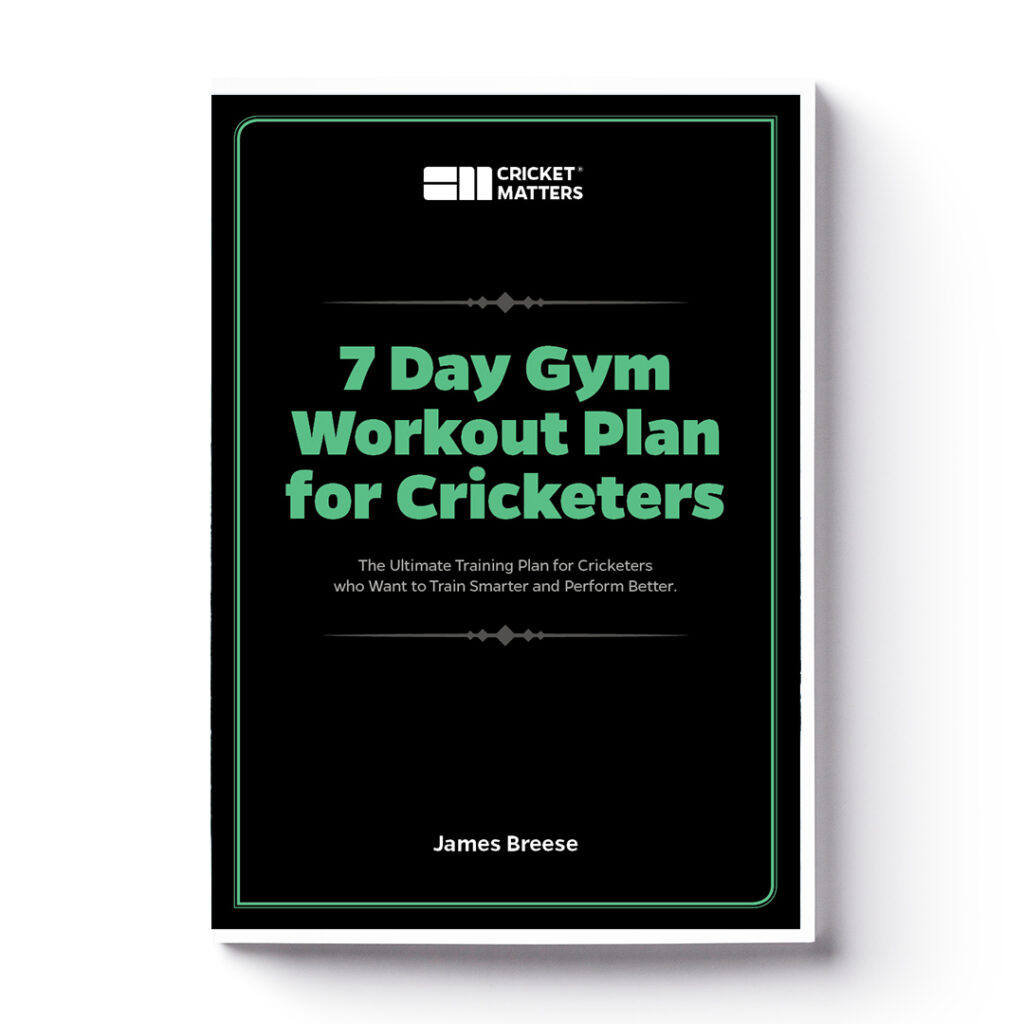
Have You Downloaded Our FREE 7-Day Gym Workout Plan?
Grab your complete step-by-step 7-day gym workout plan for cricketers today. There will be no more Guesswork. Just follow the plan and get results.
Supports Injury Rehabilitation
Injuries are part of cricket. Hamstring pulls from sprinting, rotator cuff irritation from repetitive bowling, and lower-back pain from rotational stress are all familiar. Sports massage won’t heal them alone, but it’s a powerful part of the rehab process.
Studies show its effectiveness. Pengabdian et al. (2024) found massage reduced recovery time for strains and tendinopathies, while Bedford (2021) highlighted its use in elite sport through trigger point therapy and soft tissue release.
On the ground, this means loosening hyper-tight areas around an injury, restoring blood flow, and preventing compensations that create secondary issues. A bowler with a side strain, for example, might overload their QL and obliques. Smart massage doesn’t just treat the strain; it addresses the surrounding muscles that stiffen and lock up, helping restore balanced movement and reducing the risk of re-injury.
Boosts Psychological Recovery
Cricket is as mentally demanding as it is physical. Long spells in the field, high-pressure situations, and the grind of travel all wear players down. A tired body can be treated, but a tired mind is harder to reset.
Massage has well-documented psychological benefits. Tarigan et al. (2024) found reductions in stress, anxiety, and depression, while Reichert (2020) observed consistent mood improvements across athlete groups.
For cricketers, that translates to stepping into day two of a multi-day match with a clearer head, instead of feeling heavy and drained. A session that releases tension in the neck and shoulders doesn’t just improve posture — it triggers a relaxation response, improving focus and confidence. It’s one of the simplest ways to mentally reset between performances.
Helps Maintain Focus and Readiness
Mental fatigue shows itself in poor decisions: the loose shot after hours at the crease, the no-ball in the 18th over, or the fielder switching off just as the ball comes their way. Nikolovska et al. (2012) demonstrated massage’s ability to reduce mental fatigue and improve readiness — particularly valuable in tournament settings where matches stack up quickly.
In cricketing terms, this is about finishing strong. A batter who recovers better mentally is more likely to sustain concentration into the final session. A bowler can stay locked in through their 20th over, not just their fifth. Massage resets both body and mind, ensuring you’re sharp when the pressure is highest.
Massage doesn’t win matches, but it creates the conditions for better performance.
What the Research Doesn’t Fully Support
Sports massage is powerful, but it isn’t a magic bullet. One of the most important parts of using it effectively is managing expectations — both for players and coaches.
Here’s what the evidence makes clear: massage does not directly make you faster, stronger, or fitter. It won’t add yards to your sprint time, give you an extra 10kg on your squat, or suddenly increase your endurance.
Studies show that while massage consistently improves recovery and perceived readiness, there’s little proof it translates into direct performance gains in raw speed, strength, or aerobic capacity (Davis et al., 2020).
The same applies to some of the common physiological claims. You’ll often hear that massage “flushes lactic acid,” “dramatically boosts blood flow,” or “clears toxins.”
The reality is more nuanced.
Research does show massage can increase superficial blood flow and support lymphatic drainage, which helps reduce swelling and fluid build-up. But the effects on deeper muscle perfusion or lactate clearance are far less consistent (Shamsi et al., 2022). In other words: massage supports circulation and recovery, but it’s not a replacement for proper conditioning, smart nutrition, or quality sleep.
This distinction is crucial when talking to sceptical athletes. Oversell massage as a way to magically bowl faster or hit harder, and you’ll lose credibility. Frame it accurately — as a recovery and maintenance tool that helps players train harder, avoid injury, and perform more consistently — and it becomes invaluable.
Massage doesn’t win matches on its own. But by keeping your body fresher, sharper, and less prone to breakdown, it creates the conditions for better performance. That’s the realistic, evidence-based promise.
Who Should Not Get Sports Massage (Right Now)
Skip or modify massage if you have an acute injury (sudden tear, severe swelling, heavy bruising), active infection/fever, open wounds or skin irritation at the treatment site, or red-flag symptoms (unexplained calf pain, chest pain, shortness of breath). Recent surgery follows clinical timelines. Pre-match, keep work light and avoid deep treatment on muscles you rely on to perform.
When Should Cricketers Use Sports Massage?
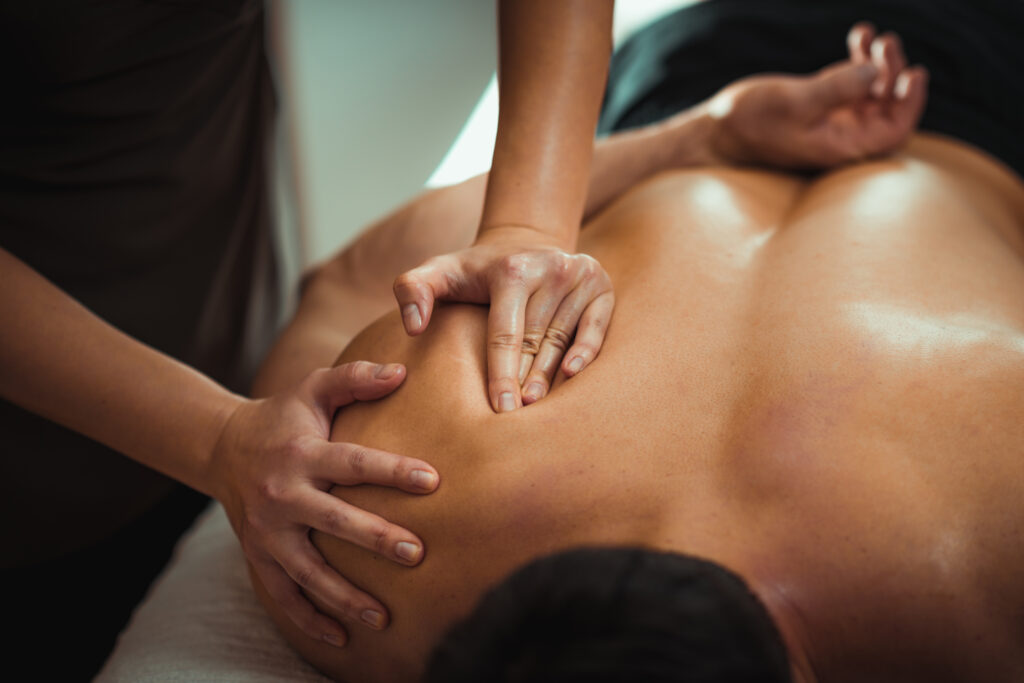
Timing is everything. To get the most from sports massage, you have to think about where it fits across a cricketer’s year — pre-season, in-season, and off-season. The purpose changes with the phase: sometimes you want activation and sharpness, sometimes deep recovery, and sometimes just enough maintenance to keep overload from turning into injury.
Pre-Match
Before competition, massage should be light, quick, and stimulating — not heavy or draining. The goal here isn’t to strip muscles down but to prime them for action. A flush through the calves, hamstrings, and quads wakes up the legs for sharper sprints.
Gentle mobilisation around the shoulders and rotator cuff helps bowlers find a smoother action. Release through the obliques and hips frees up rotation, giving batters the range they need to play with power and fluidity.
Think of it as flicking the “on” switch. Done well, a pre-match massage reduces stiffness, improves mobility, and gives players the feeling of being loose and ready to perform.
Post-Match
After competition, the focus flips to recovery and repair. This is where slower, deeper work pays off — easing out tight calves and anterior tibialis after long days of sprinting, releasing tension in the lower back and QL from overs of bowling, and loosening shoulders that stiffen after hours at the crease.
Scheduling massage after a 50-over game is particularly powerful. Instead of waking up the next day with heavy legs and stiff joints, players often feel lighter, fresher, and ready to train again sooner. Improved circulation and lymphatic drainage also help shift fluid build-up and swelling, keeping recovery on track between fixtures.
During Heavy Training Blocks
Pre-season is when players often push the hardest in the gym and nets — building strength, fitness, and technical volume. But high workloads bring risk: tight hamstrings from sprinting, shoulder irritation from repeated bowling, or hip stiffness from long batting drills.
Massage in this phase acts as maintenance. By releasing overloaded areas before they break down, it helps players sustain higher training volumes safely. Trigger point work in the rotator cuff, flushes through the posterior chain, and targeted hip release all keep tissues mobile and resilient during intense blocks.
Off-Season vs In-Season
Massage’s role also shifts with the calendar. In the off-season, when fixtures are sparse, sessions can be less frequent — used strategically to support heavy training or iron out niggles. A treatment every few weeks may be enough to keep players moving well.
In-season, with the added strain of travel, matches, and shorter recovery windows, frequency should rise. A weekly session often makes the difference between carrying fatigue into the next match or arriving sharp and prepared.
For players juggling multiple formats or back-to-back fixtures, massage isn’t an optional extra — it becomes a cornerstone of recovery.
How Often Should Cricketers Get Sports Massage?
The honest answer: it depends. A recreational player training once a week won’t need the same frequency as a professional playing three formats. But if you’re training and competing regularly, a minimum of two sessions per month is a smart baseline. It helps keep soreness under control, prevents niggles from becoming injuries, and maintains mobility in the muscle groups cricket stresses most.
For serious players and semi-professionals, a weekly session should be the standard. That level of consistency supports ongoing maintenance of the shoulders, hips, hamstrings, and lower back, while accelerating recovery between matches.
At the elite level, massage becomes part of the weekly rhythm — sometimes even multiple times per week during tournaments or heavy schedules. Top athletes don’t treat it as a luxury; they treat it as essential upkeep, just like strength training, nutrition, and skill work.
If your only aim is to get through a season, you can scrape by with the occasional massage. But if your ambition is to perform at your best, stay injury-free, and keep improving, then massage needs to be part of your regular schedule — not just something you turn to when you’re already sore.
Sports massage won’t magically add pace — but it will keep you fresher, sharper, and more durable.
Sports Massage vs Other Recovery Tools
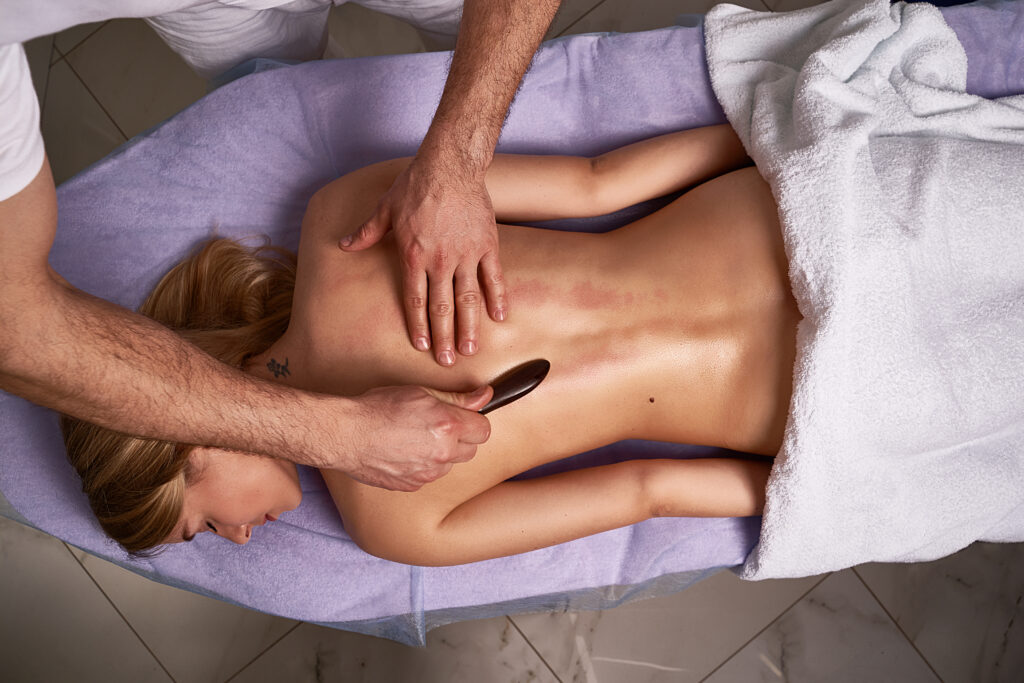
Cricketers have more recovery options now than ever before — foam rollers, stretching routines, ice baths, massage guns, compression boots from brands like Hyperice and Normatec, and of course, nutrition. The question isn’t which one to use, but how sports massage compares — and why the best players use them together.
Foam Rolling
Foam rolling is essentially self-massage. It’s convenient, cost-effective, and useful for quick maintenance before or after training. But it has limits.
A roller only works on broad areas and relies on you applying pressure yourself. It can’t reach deep structures or smaller cricket-specific muscles like the rotator cuff, serratus anterior, or anterior tibialis.
Sports massage goes further: a skilled therapist can adapt in real time, change angles, and release tension in ways a roller simply can’t. That’s why pro teams combine the two — foam rolling for day-to-day upkeep, massage for precise, deeper work.
Stretching
Stretching improves flexibility and mobility, but it doesn’t release tight knots or adhesions. A bowler with locked-up obliques can stretch all day and still feel restricted. Massage works directly into those tissues, creating the conditions for stretching to be more effective. Think of massage as clearing the roadblocks, and stretching as expanding your range once the road is clear.
Ice Baths
Ice baths are a favourite for reducing inflammation and soreness after long matches or tournaments. They can help cricketers feel fresher in the short term, but they don’t improve tissue quality or resolve muscular restrictions.
Massage, on the other hand, restores mobility, improves circulation, and resets movement patterns. That’s why elite players often use both — ice baths for immediate relief, followed by massage to maintain long-term muscle health.
Massage Guns
Massage guns are a step up from foam rollers, allowing you to target specific muscles with percussive therapy. They’re excellent for loosening superficial tension, especially when travelling or between matches.
But like rollers, they’re limited. They can’t assess movement, adjust pressure, or work into complex areas like the shoulder cuff or deep hip structures. A massage gun is a handy self-care tool, but it doesn’t replace the hands of an experienced therapist.
Compression Boots (Hyperice, Normatec, etc.)
Compression systems use air pressure to flush fluid and improve circulation, making them brilliant after long days in the field or heavy travel. They help with leg fatigue and swelling, but they don’t release muscular tension. They’re passive, not corrective. Used alongside massage, though, they’re a powerful addition: compression to refresh the legs, massage to restore tissue quality and keep movement smooth.
Nutrition
No recovery plan works without nutrition. Massage reduces soreness, improves circulation, and restores mobility — but if you’re under-fuelling, dehydrated, or missing protein, your body won’t repair properly. Hydration, adequate protein, and smart refuelling after matches provide the building blocks for recovery. Massage clears the roadblocks; nutrition lays the tarmac. Together, they allow you to recover faster, train harder, and play better across a long season.
The Bottom Line
Foam rollers, stretching, ice baths, massage guns, compression boots, and nutrition all have their place. But sports massage fills the gap none of them can: precise, intelligent, hands-on treatment of the muscles and movement patterns cricket relies on most.
That’s why professionals don’t pick one recovery tool — they combine them. The smartest cricketers don’t ask “Which is better?” but “How do I use them together to stay fresher, recover faster, and perform better every ball?”
Practical Takeaways for Cricketers
Knowing the science is one thing. Putting it into practice is what actually makes the difference. Here’s how cricketers can use sports massage effectively.
Frequency
How often you should get a massage depends on your schedule, but there are clear benchmarks. In-season, when demands are highest and recovery windows are short, weekly sessions are the gold standard.
They keep soreness down, maintain mobility, and stop tension from building up across a packed fixture list. In the off-season, when workloads are lighter, fortnightly sessions are usually enough to stay on top of niggles while building strength and fitness.
Session Length
Massage doesn’t have to mean a marathon session.
- 30 minutes → best for quick tune-ups, especially when one area like the shoulders, calves, or lower back needs attention.
- 60 minutes → the sweet spot for most cricketers. Long enough for thorough recovery or targeted work on batting, bowling, or fielding demands, without leaving you drained.
- 90 minutes → built for serious players with heavy workloads or tournament prep. Allows full-body treatment, deep tissue release, and mobility work across multiple areas in one sitting.
Choosing the Right Therapist
Not all massage is equal. A spa therapist might be excellent at relaxation, but cricket-specific demands require more. Look for a practitioner with sports experience who understands movement, overload, and the stresses of cricket. The right therapist will target high-impact areas such as the rotator cuff, anterior tibialis, obliques, QL, and serratus — not just give a generic rubdown.
Advice for Parents
If you’re a parent booking your child’s first sports massage, treat it as part of their athletic development, not a luxury. Choose a therapist who works with athletes, explain the type of training and matches your child does, and start with shorter sessions to ease them in.
Done well, massage helps young cricketers recover quicker, stay injury-free, and learn the value of looking after their bodies — lessons that will pay off for the rest of their careers.
Why We Offer Different Options
At Cricket Matters, we provide different session lengths for exactly this reason.
Not every cricketer needs the same approach. A bowler coming off a heavy workload will benefit from a longer session covering multiple areas, while a batter managing shoulder tightness might only need targeted 30-minute work.
By matching session length and focus to your goals, workload, and position, you get the recovery that makes the biggest difference where it counts: out in the middle.
How to Know It’s Working
Track simple markers for 2–4 weeks: DOMS the next day and at 48h, session RPE in nets, a couple of ROM checks (shoulder external rotation, thoracic rotation, hip rotation), and availability (pain-free overs, time in field, batting duration before fatigue cues). If nothing improves, adjust timing, techniques, or frequency.
Massage is performance upkeep — as essential as nets, training, and recovery.
Conclusion: The Bottom Line for Serious Cricketers
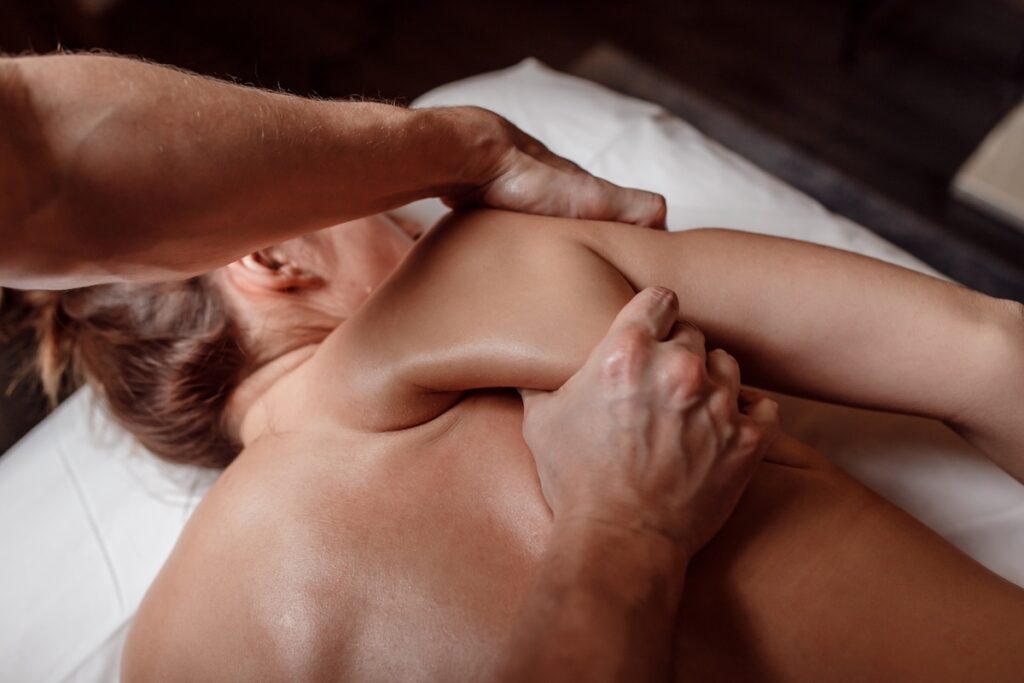
You don’t win games by being sore, stiff, or carrying niggles week after week. You win them by being fresh enough to train hard, mobile enough to move well, and sharp enough to keep your technique intact under pressure.
That’s exactly what sports massage gives you when it’s done properly. It won’t magically add pace to your bowling or power to your hitting — the research is clear on that — but it will keep you in the best possible condition to perform.
Less soreness, smoother movement, fewer injuries, and a clearer head when the game goes long.
The mistake most cricketers make is treating massage like a luxury. It’s not. It’s performance upkeep — no different from nets, strength training, or proper recovery.
Used consistently, it reduces fatigue, frees up the joints that matter, and lowers the risk of breakdowns. Ignore it, and you end up fighting against your own body as the season drags on.
If you’re serious about your cricket, this is where we can help.
At Cricket Matters, we don’t offer generic massages — we live and breathe cricket. We know the areas that take the biggest hammering, from the anterior tibialis to the rotator cuff, from the obliques to the QL.
We know what a bowler’s workload does to the body, how batting tightens the hips and shoulders, and how travel and fielding sap energy. And we know how to target those areas so you recover faster, move better, and play stronger every ball.
The next step is simple: book in with a team that understands cricket inside out. Get the recovery and upkeep your game deserves — because if you’re not looking after your body, you’re already leaving runs and wickets out there.

Have You Downloaded Our FREE 7-Day Gym Workout Plan?
Grab your complete step-by-step 7-day gym workout plan for cricketers today. There will be no more Guesswork. Just follow the plan and get results.
FAQ
What Is a Sports Massage for Cricketers?
A sports massage for cricketers is designed to support the physical demands of batting, bowling, and fielding. It focuses on reducing muscle soreness, improving mobility, and addressing tight areas that build up during training or matches. Unlike general relaxation massage, it is goal-oriented — helping cricketers recover faster, prevent injuries, and maintain consistent performance across long seasons.
What Is the Difference Between a Sports Massage and a Regular Massage?
A regular massage is usually aimed at relaxation and stress relief, with broad techniques that make the body feel looser and calmer. A sports massage, by contrast, is targeted and functional. For cricketers, this means working on high-stress areas like the shoulders, lower back, hips, and legs to improve movement and reduce fatigue. It is more specific, often deeper, and directly linked to athletic recovery and performance.
How Do I Know if I Need a Sports Massage as a Cricketer?
You may benefit from a sports massage if you often feel sore, stiff, or restricted after training or matches. Signs include tight shoulders that affect bowling rhythm, sore legs after fielding, or limited hip rotation when batting. Even without injury, regular tension in these areas can reduce performance. Sports massage helps manage these issues before they turn into bigger problems, making it useful for both recovery and long-term maintenance.
When Should Cricketers Avoid Sports Massage?
Sports massage is generally safe, but there are times when it should be avoided. Cricketers with acute injuries such as fractures, open wounds, or severe inflammation should not have massage on the affected area. It is also not advised if you have certain medical conditions like deep vein thrombosis, active infections, or uncontrolled high blood pressure. In these cases, it’s best to consult a medical professional before booking a session.
How Long Do Sports Massages for Cricketers Take?
The length of a sports massage depends on the goal and the areas being treated. A short 30-minute session is often used for quick recovery or to target one specific area such as the shoulders or calves. A 60-minute session is the most common length, allowing for thorough treatment of multiple cricket-related areas. Ninety minutes is usually reserved for deeper, full-body recovery or during heavy playing and training periods when several muscle groups need attention.

